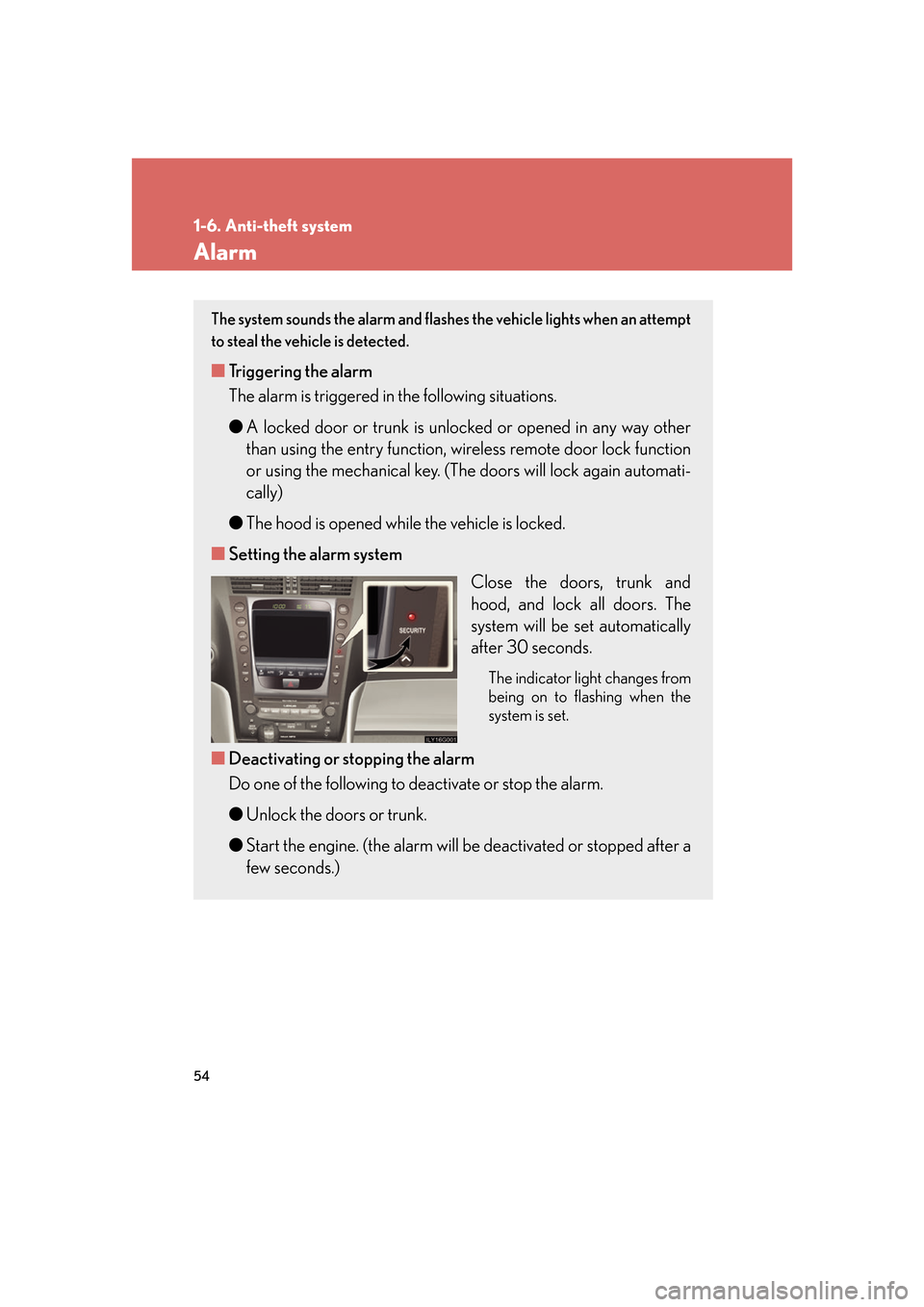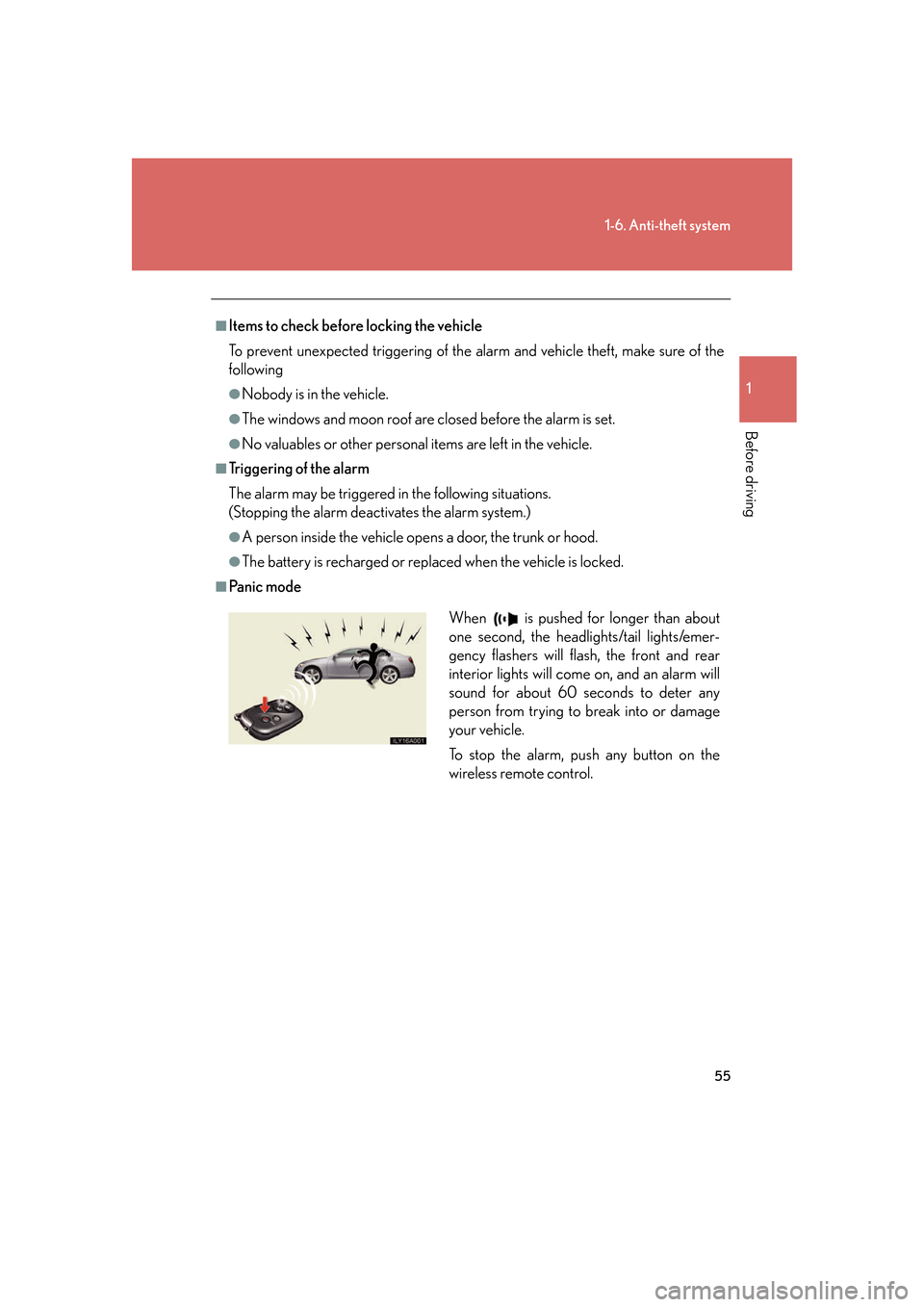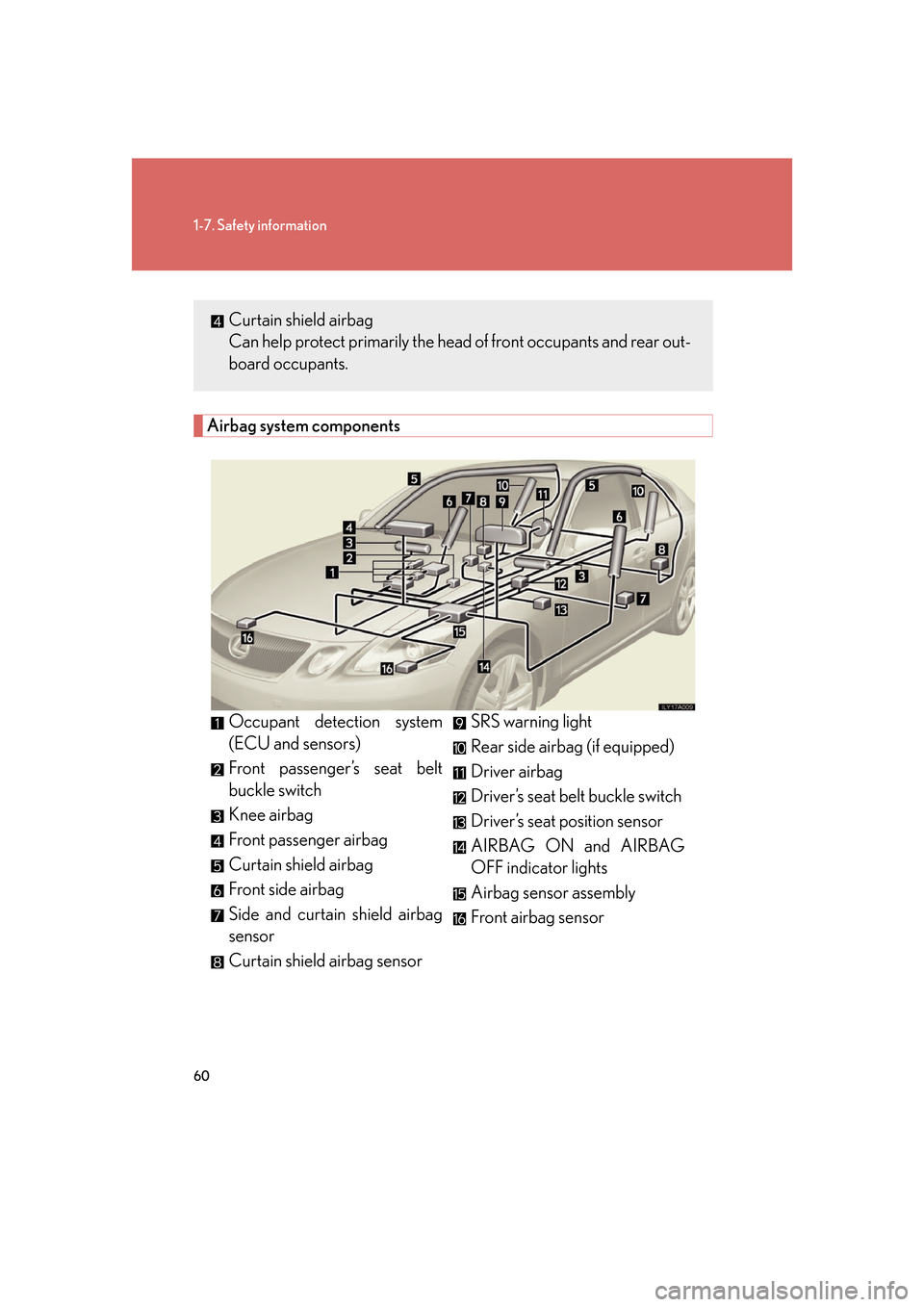Lexus GS350 2007 Using the front audio system / LEXUS 2007 GS430/350 (OM30A04U) Manual PDF
Manufacturer: LEXUS, Model Year: 2007, Model line: GS350, Model: Lexus GS350 2007Pages: 562, PDF Size: 17.95 MB
Page 71 of 562

51
1-5. Refueling
1
Before driving
CAUTION
■When refueling the vehicle
Observe the following precautions while refueling the vehicle. Failure to do so, may
result in death or serious injury.
●Touch the vehicle or some other metal surface to discharge any static electricity.
Sparks resulting from discharging static electricity may cause the fuel vapors to
ignite.
●Always hold the grips on the fuel tank cap and turn it slowly to remove it.
A whooshing sound may be heard when the fuel tank cap is loosened. Wait until
the sound cannot be heard before fully re moving the cap. In hot weather, pressur-
ized fuel may spray out the filler neck and cause injury.
●Do not allow anyone that has not discharged static electricity from their bodies to
come close to an open fuel tank.
●Do not inhale vaporized fuel.
Fuel contains substances that are harmful if inhaled.
●Do not smoke while refueling the vehicle.
Doing so may cause the fuel to ignite and cause a fire.
●Do not return to the vehicle or touch an y person or object that is statically
charged.
This may cause static electricity to build up , resulting in a possible ignition hazard.
■When replacing the fuel tank cap
Do not use anything but a genuine Lexus fuel tank cap designed for your vehicle.
Failure to do so may cause a fire or other incident which may result in death or seri-
ous injury.
NOTICE
■Refueling
Do not spill fuel during refueling.
Failing to do so may damage the vehicle, such as causing the exhaust systems to
operate abnormally or damaging fuel system components or the vehicle's painted
surface.
Page 72 of 562

52
1-6. Anti-theft system
Engine immobilizer system
■System maintenance
The vehicle has a maintenance-free type of engine immobilizer system.
■Conditions that may cause the system to malfunction
●If the grip portion of the key is in contact with a metallic object.
●If the key is in close proximity to or touching a key to the security system (key
with a built-in transponder chip) of another vehicle.
■Certifications for the engine immobilizer system For vehicles sold in the U.S.A.
This device complies with Part 15 of the FCC Rules. Operation is subject to the fol -
lowing two conditions: (1) this device may not cause harmful interference, and (2)
this
device must accept any interference received, including interference that may
cause undesired operation.
For vehicles sold in Canada
Operation is subject to the following two co
nditions: (1) this device may not cause
interference, and (2) this device must accept any interference, including interfer -
ence that may cause undesired operation of the device.
The vehicle's keys have built-in transponder chips that prevent the engine
from starting if the key has not been previously registered in the vehicle's
on-board computer.
Never leave the keys inside the vehicle when you leave the vehicle.
The indicator light flashes after
the engine switch has been
turned “OFF” to indicate that
the system is operating.
FCC ID: NI4TMIMB-1
Page 73 of 562

53
1-6. Anti-theft system
1
Before driving
CAUTION
■Certifications for the engine immobilizer system
Changes or modifications not expressly approved by the party responsible for
compliance could void the user’s authority to operate the equipment.
NOTICE
■For proper system operation
Do not modify, remove or disable the engine immobilizer system. If any unautho-
rized changes or modifications are made, the proper operation of the system can-
not be guaranteed.
Page 74 of 562

54
1-6. Anti-theft system
Alarm
The system sounds the alarm and flashes the vehicle lights when an attempt
to steal the vehicle is detected.
■ Triggering the alarm
The alarm is triggered in the following situations.
●A lock
ed door or trunk is unlocked or opened in any way other
than using the entry function, wire less remote door lock function
or using the mechanical key. (The doors will lock again automati -
cally)
● The hood is opened while the v
ehicle is locked.
■ Setting the alarm sy
stem
Close the doors, trunk and
hood, and lock all door
s. The
system will be set automatically
after 30 seconds.
The indicator light changes from
being on to flashing when the
system is set.
■ Deactivating or stopping the alarm
Do one of the following to deactivate or stop the alarm.
●Unlock the doors or trunk.
● Star
t the engine. (the alarm will be deactivated or stopped after a
few seconds.)
Page 75 of 562

55
1-6. Anti-theft system
1
Before driving
■Items to check before locking the vehicle
To prevent unexpected triggering of the alarm and vehicle theft, make sure of the
fo
llowing
●Nobody is in the vehicle.
●The windows and moon roof are closed before the alarm is set.
●No valuables or other personal items are left in the vehicle.
■Tr i g g e r i n g o f t h e a l a r m
The alarm may be triggered in the
following situations.
(Stopping the alarm deactivates the alarm system.)
●A person inside the vehicle opens a door, the trunk or hood.
●The battery is recharged or replaced when the vehicle is locked.
■Pa n i c m o d e
When is pushed for longer than about
one second, the headlights/tail lights/emer-
gency flashers will flash, the front and rear
interior lights will come on, and an alarm will
sound for about 60 seconds to deter any
person from trying to break into or damage
your vehicle.
To stop the alarm, push any button on the
wireless remote control.
Page 76 of 562

56
1-6. Anti-theft system
Theft prevention labels (U.S.A.)
These labels are attached to the
vehicle to reduce vehicle theft
by facilitating the tracing and
recovery of parts from stolen
vehicles. Do not remove under
penalty of law.
Page 77 of 562

57
1
Before driving
1-7. Safety information
Correct driving posture
Drive with a good posture as follows:
Sit upright and well back in
the seat.
Adjust the position of the seat
forward or backward to
ensur
e the pedals can be
reached and easily
depressed to the extent
required. ( P. 2 5 )
Adjust the seatback so that
the controls are easily opera -
ble.
Adjust the tilt and telescopic
positions of the steering
wheel do
wnward so the air -
bag is facing your chest.
( P. 39 )
Lock the head restraint in
place with the center of the
head r
estraint closest to the
top of your ears. ( P. 31 )
Wear the seat belt correctly.
( P. 3 3 )
Page 78 of 562

58
1-7. Safety information
CAUTION
■Caution while driving
●Do not adjust the position of the driver’s seat.
Doing so could cause the driver to lose control of the vehicle.
●Do not place a cushion between the driver or passenger and the seatback.
A cushion may prevent correct posture from being achieved, and reduce the
effectiveness of the seat belt and head re straint, increasing the risk of death or
serious injury to the driver or passenger.
●Do not place anything under the front seats.
Objects placed under the front seats may become jammed in the seat tracks and
stop the seat from locking in place. This may lead to an accident. The adjustment
mechanism may also be damaged.
■Adjusting the seat position
●Do not recline the seat more than necessary when the vehicle is in motion, to
reduce the risk of slid ing under the lap belt.
If the seat is too reclined during an accident, the lap belt may slide past the hips
and apply restraint forces directly to th e abdomen or your neck may contact the
shoulder belt, increasing the ri sk of death or serious injury.
●Take care when adjusting the seat position to ensure that other passengers are
not injured by the moving seat.
●Do not put your hands under the seat or near the moving parts to avoid injury.
Fingers or hands may become jammed in the seat mechanism.
Page 79 of 562

59
1
1-7. Safety information
Before driving
SRS airbags
The SRS airbags inflate when the vehicle is subjected to certain types of
severe impacts that may cause signific ant injury to the occupants. They
work together with the seat belts to he lp reduce the risk of death or serious
injury.
Front airbags
Driver airbag/front passenger airbag
Can help protect the head and ch est of the driv
er and front passen-
ger from impact with interior components.
Knee airbag
Can help provide driver and front passenger protection.
Side and curtain shield airbags
Front side airbag/rear side airbag (r
ear side airbags are optional)
Can help protect the torso of th e f
ront occupants and rear out-
board occupants.
Page 80 of 562

60
1-7. Safety information
Airbag system components
Occupant detection system
(ECU and sensors)
Front passenger’s seat belt
buckle switch
Knee airbag
Front passenger airbag
Curtain shield airbag
Front side airbag
Side and curtain shield airbag
sensor
Curtain shield airbag sensorSRS warning light
Rear side airbag (if equipped)
Driver airbag
Driver’s seat belt buckle switch
Driver’s seat position sensor
AIRBAG ON and AIRBAG
OFF indicator lights
Airbag sensor assembly
Front airbag sensor
Curtain shield airbag
Can help protect primarily the head of fr
ont occupants and rear out-
board occupants.